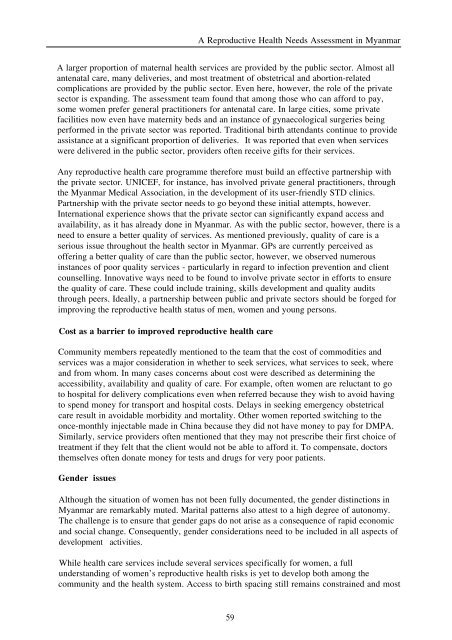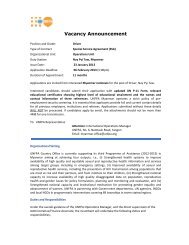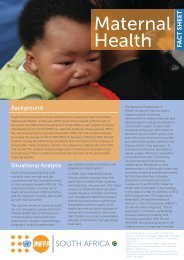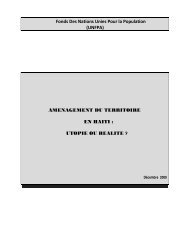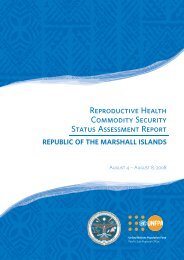A reproductive health needs assessment in Myanmar
A reproductive health needs assessment in Myanmar
A reproductive health needs assessment in Myanmar
You also want an ePaper? Increase the reach of your titles
YUMPU automatically turns print PDFs into web optimized ePapers that Google loves.
A Reproductive Health Needs Assessment <strong>in</strong> <strong>Myanmar</strong><br />
A larger proportion of maternal <strong>health</strong> services are provided by the public sector. Almost all<br />
antenatal care, many deliveries, and most treatment of obstetrical and abortion-related<br />
complications are provided by the public sector. Even here, however, the role of the private<br />
sector is expand<strong>in</strong>g. The <strong>assessment</strong> team found that among those who can afford to pay,<br />
some women prefer general practitioners for antenatal care. In large cities, some private<br />
facilities now even have maternity beds and an <strong>in</strong>stance of gynaecological surgeries be<strong>in</strong>g<br />
performed <strong>in</strong> the private sector was reported. Traditional birth attendants cont<strong>in</strong>ue to provide<br />
assistance at a significant proportion of deliveries. It was reported that even when services<br />
were delivered <strong>in</strong> the public sector, providers often receive gifts for their services.<br />
Any <strong>reproductive</strong> <strong>health</strong> care programme therefore must build an effective partnership with<br />
the private sector. UNICEF, for <strong>in</strong>stance, has <strong>in</strong>volved private general practitioners, through<br />
the <strong>Myanmar</strong> Medical Association, <strong>in</strong> the development of its user-friendly STD cl<strong>in</strong>ics.<br />
Partnership with the private sector <strong>needs</strong> to go beyond these <strong>in</strong>itial attempts, however.<br />
International experience shows that the private sector can significantly expand access and<br />
availability, as it has already done <strong>in</strong> <strong>Myanmar</strong>. As with the public sector, however, there is a<br />
need to ensure a better quality of services. As mentioned previously, quality of care is a<br />
serious issue throughout the <strong>health</strong> sector <strong>in</strong> <strong>Myanmar</strong>. GPs are currently perceived as<br />
offer<strong>in</strong>g a better quality of care than the public sector, however, we observed numerous<br />
<strong>in</strong>stances of poor quality services - particularly <strong>in</strong> regard to <strong>in</strong>fection prevention and client<br />
counsell<strong>in</strong>g. Innovative ways need to be found to <strong>in</strong>volve private sector <strong>in</strong> efforts to ensure<br />
the quality of care. These could <strong>in</strong>clude tra<strong>in</strong><strong>in</strong>g, skills development and quality audits<br />
through peers. Ideally, a partnership between public and private sectors should be forged for<br />
improv<strong>in</strong>g the <strong>reproductive</strong> <strong>health</strong> status of men, women and young persons.<br />
Cost as a barrier to improved <strong>reproductive</strong> <strong>health</strong> care<br />
Community members repeatedly mentioned to the team that the cost of commodities and<br />
services was a major consideration <strong>in</strong> whether to seek services, what services to seek, where<br />
and from whom. In many cases concerns about cost were described as determ<strong>in</strong><strong>in</strong>g the<br />
accessibility, availability and quality of care. For example, often women are reluctant to go<br />
to hospital for delivery complications even when referred because they wish to avoid hav<strong>in</strong>g<br />
to spend money for transport and hospital costs. Delays <strong>in</strong> seek<strong>in</strong>g emergency obstetrical<br />
care result <strong>in</strong> avoidable morbidity and mortality. Other women reported switch<strong>in</strong>g to the<br />
once-monthly <strong>in</strong>jectable made <strong>in</strong> Ch<strong>in</strong>a because they did not have money to pay for DMPA.<br />
Similarly, service providers often mentioned that they may not prescribe their first choice of<br />
treatment if they felt that the client would not be able to afford it. To compensate, doctors<br />
themselves often donate money for tests and drugs for very poor patients.<br />
Gender issues<br />
Although the situation of women has not been fully documented, the gender dist<strong>in</strong>ctions <strong>in</strong><br />
<strong>Myanmar</strong> are remarkably muted. Marital patterns also attest to a high degree of autonomy.<br />
The challenge is to ensure that gender gaps do not arise as a consequence of rapid economic<br />
and social change. Consequently, gender considerations need to be <strong>in</strong>cluded <strong>in</strong> all aspects of<br />
development activities.<br />
While <strong>health</strong> care services <strong>in</strong>clude several services specifically for women, a full<br />
understand<strong>in</strong>g of women’s <strong>reproductive</strong> <strong>health</strong> risks is yet to develop both among the<br />
community and the <strong>health</strong> system. Access to birth spac<strong>in</strong>g still rema<strong>in</strong>s constra<strong>in</strong>ed and most<br />
59


